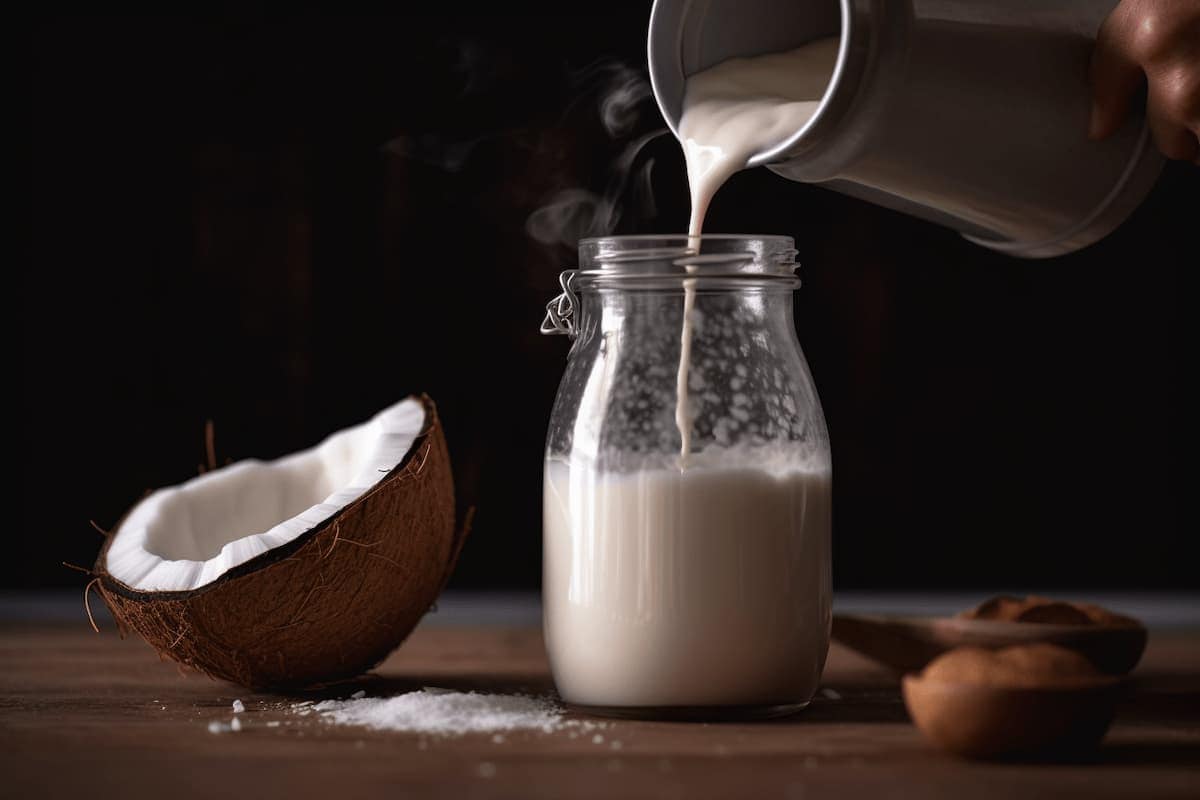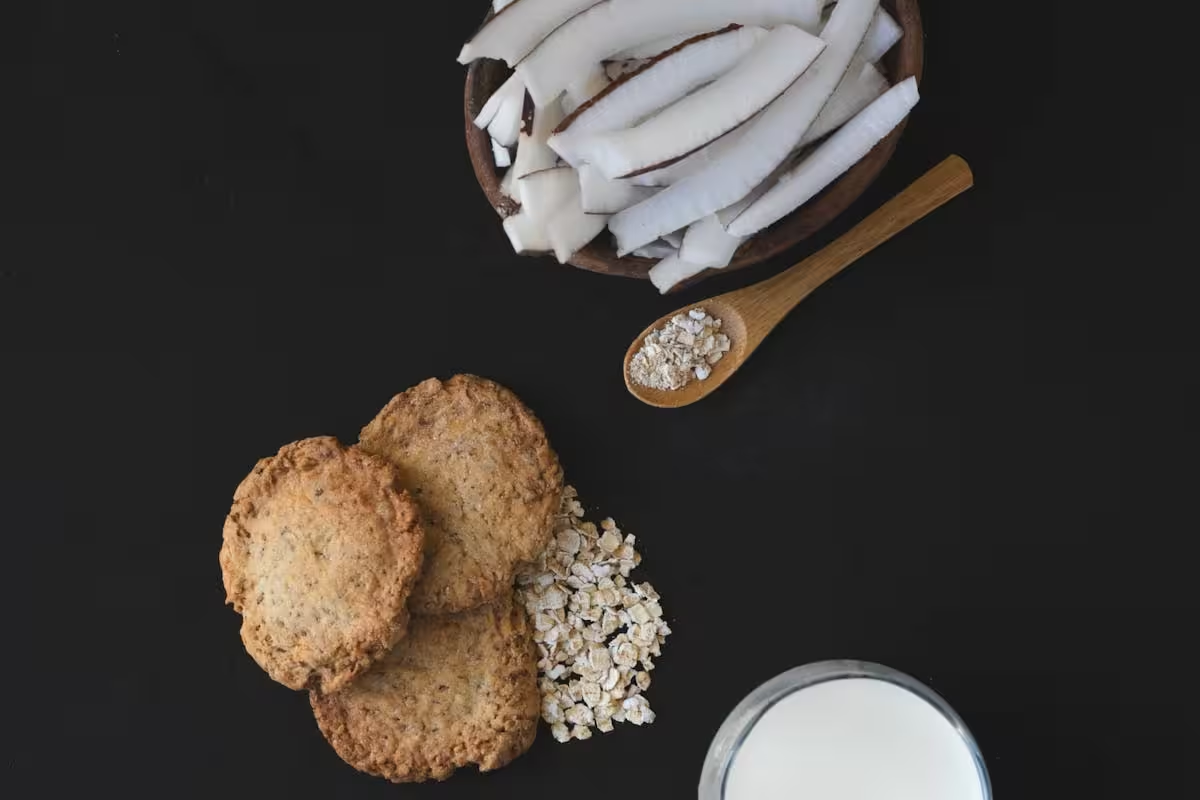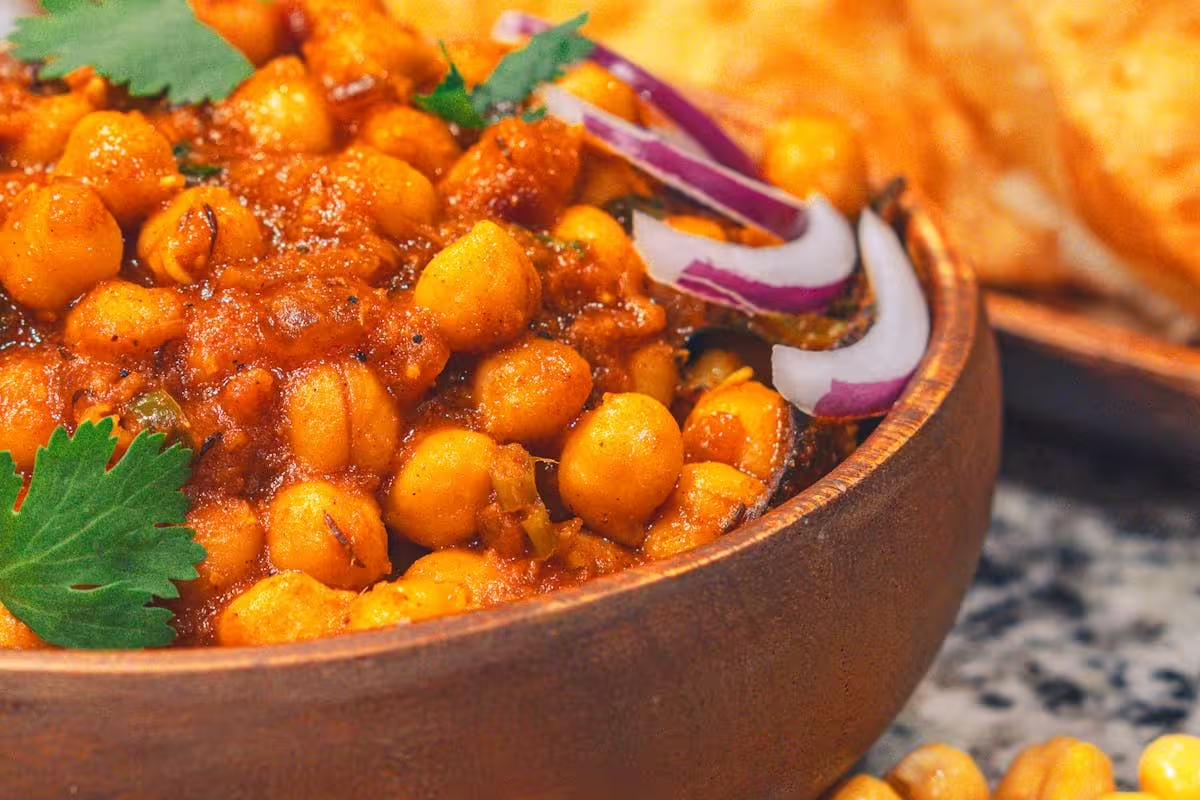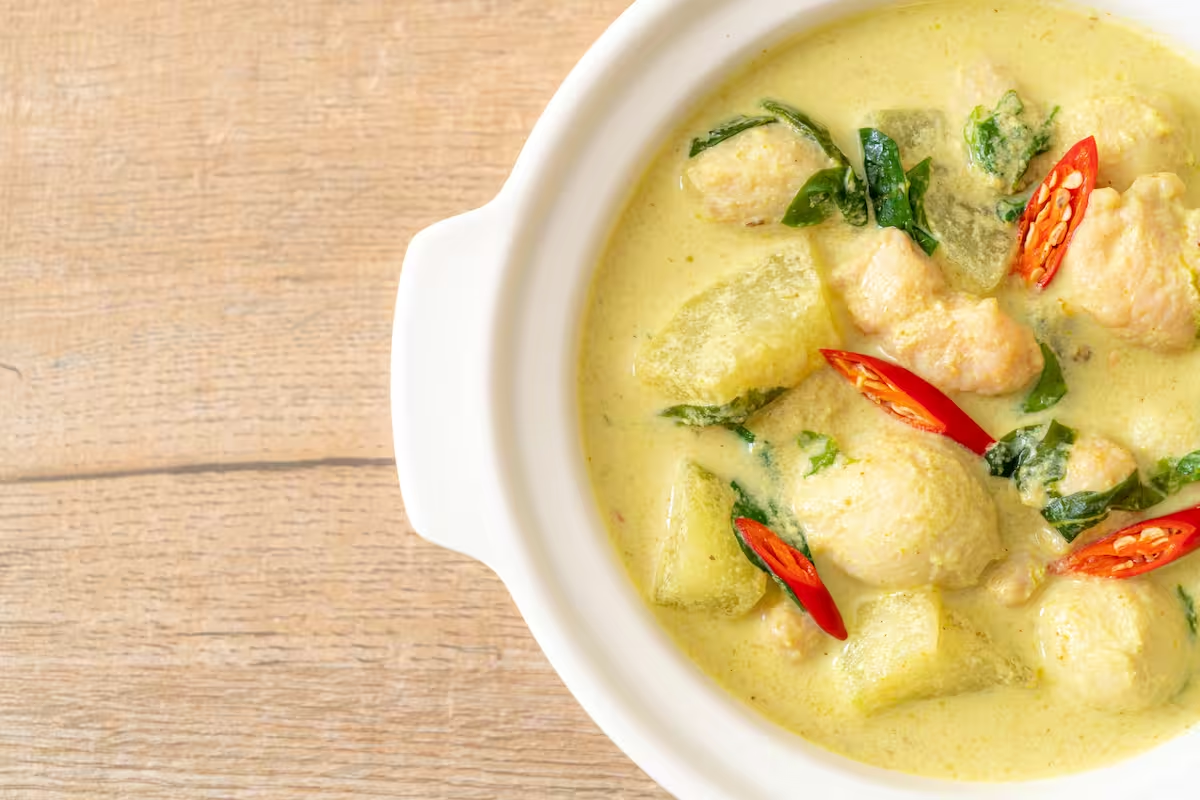In this article, we will describe what coconut milk is, its nutritional composition, as well as 4 delicious recipes to try.
Coconut milk (Cocos nucifera) has been, ancestrally, the base of tropical and oriental cultures for centuries, and its popularity has increased due to its multiple uses.
Therefore, we will provide examples of its use in oriental cuisine to integrate this plant-based drink into our dishes.
What is coconut milk?
Coconut milk is a food commonly obtained from the grated pulp of the coconut (nut) and then pressed with hot water. Unlike coconut milk, coconut water is concentrated inside the young coconut before maturation (1).
In fact, the definition established by various authors such as Ohler, 1999; Chiewchan et al; 2005 and Tansakul and Chaisawang, 2005, is as follows: “emulsion of fat in water, white in color, obtained by compressing disintegrated coconut meat, using or not, its water or potable water, and subsequent sieving of the obtained milk, in order to eliminate the crude fiber present in the final product” (1).
In terms of composition, coconut milk is high in lipids, proteins, and carbohydrates.
Compared to coconut milk, the water of this fruit is low in calories and lipids, being a natural isotonic drink. The following table shows a comparison between the characteristics of coconut milk and coconut water (2).
|
Attribute |
Coconut Milk |
Coconut Water |
|---|---|---|
| Flavor | Creamy and sweet | Refreshing and sweet |
| Color | White | Transparent |
| Texture | Thick and creamy | Thin and watery |
| Source | Extracted from grated pulp of mature coconuts | Found inside young and green coconuts |
| Use | Used in cooking, and as a milk substitute | Consumed as a drink |
| Nutritional Content | High in calories, fat, and proteins | Low in calories, fat, and proteins |
Nutritional composition of coconut milk
Below is a table with the nutritional composition of coconut milk (7):
|
Nutrient |
Amount per 100 ml |
|---|---|
| Calories | 230 kcal |
| Total Fats | 24 g |
| Saturated Fats | 21 g |
| Cholesterol | 0 mg |
| Sodium | 15 mg |
| Total Carbohydrates | 5.54 g |
| Dietary Fiber | 2.2 g |
| Sugars | 3 g |
| Proteins | 2.29 g |
| Vitamin C | 2.8 mg |
| Iron | 1.6 mg |
| Potassium | 263 mg |
Coconut milk: properties, benefits, and uses
This plant-based drink is a recurring ingredient in Asian cuisines mainly, with this region also being its largest producer. However, it is not only used in gastronomy, as it was traditionally used as a remedy for its ability to heal various diseases in ancient times.
Benefits of coconut milk
The benefits of coconut milk are largely due to its potassium content, which enhances filtration through the kidneys, also acting as a blood pressure reducer due to the counterbalance exerted on sodium effects (3).
Lauric acid and coconut milk
The composition of fatty acids is predominantly saturated, representing 92% of the total fatty acids present.
Within this group, medium-chain fatty acids (MCFAs) are the most abundant, with lauric acid standing out with an approximate concentration of 50% (3).
Lauric acid+Glycerol→Monolaurin+Water
Additionally, lauric acid is correlated with the prevention of heart attacks and strokes (3).
Culinary uses of coconut milk
Coconut milk is mainly produced in Indonesia, India, and the Philippines, and therefore, it has a strong presence in their culture and gastronomy due to its ability to provide organoleptic richness (4).
Coconut milk in Asia and Latin America
The use of this milk is directly associated with the preparation of curries and stews in Thai and Indian cuisine.
In Thai cuisine, Gaeng Kiew Wan uses it as a liquid base, facilitating the emulsification of spices such as carotenoids and capsaicin that enhance the flavor profile and color of the curry.
In Indian gastronomy, Chana Masala with coconut uses coconut milk as a balancer of the tomato’s acidity and to mitigate the spiciness of chili and turmeric.
Stews
On the other hand, this product acts as an emulsifying and thickening agent, improving the rheological properties of preparations, thus enhancing the sensory perception of the dish in Tom Kha Gay soup from Thailand and Laksa from Malaysia.
Desserts
In desserts, specifically in coconut ice cream and mango sorbet recipes, this milk acts as a stabilizing and emulsifying agent, thus improving consistency and preventing ice crystal formation.
Coconut milk as a substitute
Coconut milk is, of course, lactose-free, so with its consumption, we avoid intolerances or for those who prefer a vegan diet.
Curry chicken with coconut milk recipe
The ingredients for this curry chicken for 4 people are as follows:
- 500 g of chicken breast, cut into pieces
- 1 can (400 ml) of coconut milk
- 2 tablespoons of curry paste (red, yellow, or green, according to your preference)
- 1 medium onion, chopped
- 2 cloves of garlic, finely chopped
- 1 red bell pepper, cut into strips
- 1 carrot, thinly sliced
- 1 tablespoon of fresh grated ginger
- 2 tablespoons of vegetable oil (sunflower, coconut, or mild olive oil)
- 1 tablespoon of soy sauce
- 1 teaspoon of sugar (optional)
- 1 cup of chicken broth or water
- Juice of 1 lime
- Fresh cilantro leaves for garnish
- Salt and pepper to taste
- Cooked basmati rice, to accompany
Nutritional content
The nutritional content of this recipe is shown below:
|
Nutrient |
Amount per 100 g |
|---|---|
| Calories | 180 kcal |
| Total Fats | 13 g |
| Saturated Fats | 10 g |
| Proteins | 12 g |
| Carbohydrates | 6 g |
| Fiber | 1.5 g |
| Sodium | 250 mg |
The preparation method for this recipe includes the following steps:
- In a Wok, sauté the chicken pieces and remove.
- In the Wok, sauté the onion, garlic, and ginger for 3 minutes and add the curry paste, stirring until integrated.
- Add the vegetables and stir for 5 minutes.
- Pour in the coconut milk and chicken broth (or water) and combine.
- Add the chicken and let it simmer for 15 minutes over low heat.
- Season with soy sauce, sugar, salt, pepper, and lime juice.
- Serve over basmati rice.
Recipes with coconut milk
Below, you will find some recipes that, although not as popular as curry chicken with coconut milk, are also a delight from the Asian continent.
Thai green curry with coconut milk
The ingredients needed for this recipe are:
- 400 ml of coconut milk
- 500 g of chicken breast, cut into pieces
- 2 tablespoons of green curry paste
- 1 eggplant, chopped
- 2 red bell peppers, cut into strips
- 1 onion, chopped
- 2 tablespoons of oil
- 1 tablespoon of fish sauce
- 1 teaspoon of sugar
- 1 cup of fresh basil leaves
- 1 cup of fresh cilantro
- 1 green chili, sliced (optional)
- 1 lime
Nutritional composition
The nutritional composition of this recipe is shown in the following table:
|
Nutrient |
Amount per 100 g |
|---|---|
| Calories | 153 kcal |
| Total Fats | 12.3 g |
| Saturated Fats | 8.5 g |
| Proteins | 10.1 g |
| Carbohydrates | 5.6 g |
| Fiber | 1.5 g |
| Sodium | 290 mg |
The preparation method for this recipe is based on the following steps:
- Heat the oil in a pan over medium heat
- Add the curry paste and sauté for 3 minutes.
- Add the chicken and brown it for 5 minutes.
- Add the coconut milk, and lower the heat for 10 minutes.
- Add the vegetables and cook for another 10 minutes.
- Add the fish sauce, sugar, and cook for 3 minutes
- Remove and add the squeezed lime, basil, and cilantro, and serve with white rice.
Colombian-style rice pudding
The ingredients for Colombian rice pudding are:
- 2 cups of white rice
- 1 can (400 ml) of coconut milk
- 1 cup of water
- 2 tablespoons of brown sugar
- 1 teaspoon of salt
- ½ cup of raisins (optional)
- 1 tablespoon of vegetable oil
Nutritional composition
The nutritional composition of this recipe is shown in the following table:
|
Nutrient |
Amount per 100 g |
|---|---|
| Calories | 210 kcal |
| Total Fats | 8.5 g |
| Saturated Fats | 7.1 g |
| Proteins | 3.2 g |
| Carbohydrates | 33.2 g |
| Fiber | 0.8 g |
| Sodium | 300 mg |
Preparation
The preparation of this rice pudding consists of the following steps:
- Heat the oil over medium heat, and brown the rice for 3 minutes.
- Add the coconut milk, sugar, water, and salt.
- Cook over high heat until it starts to boil.
- Reduce the heat to low, cover, and let cook for 20 minutes until the rice absorbs all the liquid.
- Add the raisins and mix before serving.
Khao Niew Mamuang (mango sticky rice)
The ingredients for this recipe are:
- 1 cup of rice
- 1 can (400 ml) of coconut milk
- 1/2 cup of sugar
- 1/4 teaspoon of salt
- 2 ripe mangoes, peeled and sliced
- 1 teaspoon of sesame seeds (optional)
|
Nutrient |
Amount per 100 g |
|---|---|
| Calories | 250 kcal |
| Total Fats | 7.5 g |
| Saturated Fats | 6.5 g |
| Proteins | 3 g |
| Carbohydrates | 42 g |
| Fiber | 1.1 g |
| Sodium | 60 mg |
Preparation
The preparation of mango sticky rice requires the following steps:
- Wash the rice and steam it for 20 minutes.
- Heat the coconut milk with the sugar and salt over medium heat in another container, without letting it boil.
- Mix half of the coconut milk with the rice and let it rest for 15 minutes.
- Serve the rice with the mango slices, and pour the coconut milk on top.
Mercadona coconut milk
If you’ve made it this far, you might naturally ask yourself a question. Where can I buy the best coconut milk?
Of course, there is variety when it comes to buying, however, we recommend Mercadona’s coconut milk for its quality-price ratio, in addition to being one of the latest novelties in the Levantine supermarket.
Moreover, you can achieve spectacular recipes if you combine it with oats from Mercadona itself, whose recipes you will find in the following article.
Nutritional composition of Mercadona coconut milk and comparison
|
Nutrient |
Mercadona Coconut Milk (per 100 ml) |
|---|---|
| Calories | 165 kcal |
| Total Fats | 17 g |
| Saturated Fats | 15 g |
| Carbohydrates | 2.9 g |
| Sugars | 2.5 g |
| Proteins | 0.5 g |
| Sodium | 10 mg |
| Price | 1.45€ / 400ml |
Side effects of coconut milk
Throughout the article, we have seen the benefits of coconut milk, but now we will see some problems associated with excessive consumption of this product.
- Weight gain. Due to its high-calorie content compared to other plant-based or animal drinks, such as whole cow’s milk with 66 kcal / 100 ml (8) or soy milk with 54 kcal / 100ml (9), coconut milk can be associated with a higher total caloric intake, and with a risk of weight gain.
- Allergies. Being a product derived from coconut, we may experience allergic reactions to it, with symptoms such as anaphylaxis (10), with possible cross-reactivity between coconut and other nuts, although it is a rare type of allergy (11).
- Another study shows that consuming this product three times or more a week increases the risk of vascular disease, although it also mentions that supplementation with coconut milk reduced LDL cholesterol levels, while increasing HDL cholesterol levels (12).
Conclusion
With this milk, we can prepare a number of recipes while helping to enrich them due to its great nutritional content, highlighting its significant contribution of potassium and lauric acid, which has been shown to have antiviral, antibacterial, and antiparasitic properties.
In this way, we can substitute animal milk if we have digestion problems with it.
On the other hand, it is worth noting that although coconut milk can provide great health benefits, we must consider the various side effects that could occur if we consume it excessively.
Bibliographic references
- Patil, U., & Benjakul, S. (2018). Coconut milk and coconut oil: Their manufacture associated with protein functionality. Journal of Food Science, 83(8): 2019–2027.
- Lemos, I. da M. L., Aniceto, A., & Teodoro, A. J. (2023). Coconut water: production, nutritional properties and health benefits. OBSERVATÓRIO DE LA ECONOMÍA LATINOAMERICANA, 21(2): 971–993.
- Singh, P., & Dubey, R. (2022). Coconut milk benefit human body. International Journal of Advances in Agricultural Science and Technology, 9(5): 6–13.
- Suyitno, T. (2003). Health benefit of coconut milk. Indonesian Food and Nutrition Progress, 10(2). https://doi.org/10.22146/jifnp.102
- Pehowich, D. J., Gomes, A. V., & Barnes, J. A. (2000). Fatty acid composition and possible health effects of coconut constituents. The West Indian Medical Journal, 49(2): 128–133.
- Navarro, P. et al. (2007). Coconut milk: composition, technology, and functionality. New opportunities for its conservation and use. Revista AGROLLANIA, 4: 37-52.
- U.S. Department of Agriculture. (2019, April 1). FoodData Central: Food details for food code 170172. U.S. Department of Agriculture.
- Ministerio de Agricultura, Pesca y Alimentación. (n.d.). Whole milk: Nutritional information.
- U.S. Department of Agriculture. (2019). Soymilk, original and vanilla, unfortified (SR Legacy, 172446). FoodData Central.
- Kruse, L., Lor, J., Yousif, R., Pongracic, J. A., & Fishbein, A. B. (2021). Coconut allergy: Characteristics of reactions and diagnostic predictors in a pediatric tertiary care center. Annals of Allergy, Asthma & Immunology: Official Publication of the American College of Allergy, Asthma, & Immunology, 126(5): 562-568.e1.
- Nguyen, S. A., More, D. R., Whisman, B. A., & Hagan, L. L. (2004). Cross-reactivity between coconut and hazelnut proteins in a patient with coconut anaphylaxis. Annals of Allergy, Asthma & Immunology: Official Publication of the American College of Allergy, Asthma, & Immunology, 92(2): 281–284.
- Tuminah, S., & Sihombing, M. (2015). Frequent coconut milk intake increases the risk of vascular disease in adults. Zinc supplementation improves heme biosynthesis in rats exposed to lead, 34(2): 149.




